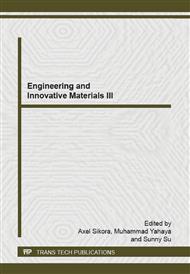[1]
D.S. Robinson Smart, 2012. Experimental Investigation of effect of abrasive jet nozzle Position and angle on coating removal Rate. International journal of manufacturing System. 1.
DOI: 10.3923/ijmsaj.2011.57.64
Google Scholar
[2]
Raykowski, A., M. Hader, B. Maragno and J.K. Spelt, 2001. Blasting cleaning of gas turbine Components: Deposit removal and substrate Deformation. Wear, 249: 126-131.
DOI: 10.1016/s0043-1648(01)00518-x
Google Scholar
[3]
D.P. Weston, P.H. Shipway, S.J. Harris, 2005. Coating removal from an Industrial polypropylene Blend by cryogenic blasting: the development Substrate damage. International journal of Wear, 258: 392-401.
DOI: 10.1016/j.wear.2004.01.021
Google Scholar
[4]
S.Y. Ahmadi-Brooghani etl, 2007. Modeling of Single-Particle Impact in Abrasive Water Jet Machining, World Academy of Science, Engineering and Technology, Vol: 1 2007-12-20.
Google Scholar
[5]
G. Fowler, I.R. Pashby, P.H. Spipway, 2009. The Effect of particle hardness and shape when Abrasive water jet milling titanium alloy Ti6A14V, International journal of Wear, 266: 613-620.
DOI: 10.1016/j.wear.2008.06.013
Google Scholar
[6]
Z.X. Yuan, Y.Y. Chen, J.G. Jiang, C.F. Ma, 2006. Swirling effect of jet impingement on heat Transfer from a flat surface fto CO2 stream, International journal of Experimental, Thermal and Fluid sciences, 31: 55-60.
DOI: 10.1016/j.expthermflusci.2005.12.007
Google Scholar
[7]
Ciampini, D., J.K. Spelt and M. Papini, 2003. Simulation of interference effects in particle Streams following impact with a flat surface: Part I. Theory and analysis. Wear, 254: 237-249.
DOI: 10.1016/s0043-1648(03)00017-6
Google Scholar
[8]
L.M. Hlavac, I.M. Hlavacova, L. Gembalova, J. Kalicinsky, S. Fabian, J. Mestanek, J. Kmec, V. Madr, 2009. Experimental method for the Investigation of the abrasive water jet cutting Quality, Journal of materials processing Technology, 209: 6190-6195.
DOI: 10.1016/j.jmatprotec.2009.04.011
Google Scholar
[9]
Arola, D., M.L. McCain, S. Kunaporn and M. Ramulu, 2002. Water jet and abrasive water jet Surface treatment of titanium: a comparison of Surface texture and residual stress. Wear, 249: 943-950.
DOI: 10.1016/s0043-1648(01)00826-2
Google Scholar
[10]
Hashish, M. and J. Stewart, 2000. Observations on precision turning with AWJ. Proceedings of 15th International Conference on Jet Cutting Technology, Sept. 6-8, Ronneby, Sweden, pp: 367-380.
Google Scholar
[11]
J. Wang, 1999. Abrasive water jet machining of polymer matrix composites cutting performance, Erosive process and predictive models, Int. J. Adv. Manul. Technol. 15, 757-768.
DOI: 10.1007/s001700050129
Google Scholar
[12]
Oka, Y.I., H. Ohnogi, T. Hosokawa and M. Matsumura, 1997. The impact angle dependence of erosion damage caused by solid particle impact. Wear, 203/204: 573-579.
DOI: 10.1016/s0043-1648(96)07430-3
Google Scholar


